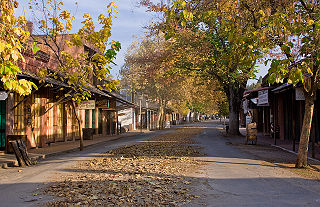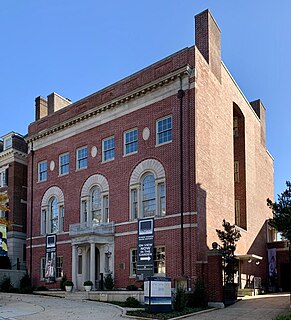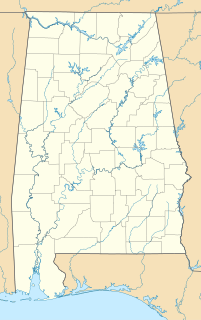
Columbia State Historic Park, also known as Columbia Historic District, is a state park unit and National Historic Landmark District preserving historic downtown Columbia, California, United States. It includes almost 30 buildings built during the California Gold Rush, most of which remain today. It was declared a National Historic Landmark in 1961.

This is a list of structures, sites, districts, and objects on the National Register of Historic Places in North Carolina:

This is intended to be a complete list of properties and districts listed on the National Register of Historic Places in Orleans County, New York. The locations of National Register properties and districts may be seen in a map by clicking on "Map of all coordinates". Two listings, the New York State Barge Canal and the Cobblestone Historic District, are further designated a National Historic Landmark.

The Woodrow Wilson House was the residence of the Twenty-Eighth President of the United States, Woodrow Wilson after he left office. It is at 2340 S Street NW just off Washington, D.C.'s Embassy Row. On February 3, 1924, Wilson died in an upstairs bedroom. It was designated a National Historic Landmark in 1964. The National Trust for Historic Preservation owns the house and operates it as a museum.

The Farm House, also known as the Knapp–Wilson House, is the oldest building on the campus of Iowa State University in Ames, Iowa. Now a museum open to the general public, this house was built 1861-65 as part of the model farm that eventually became Iowa State. It was designated a National Historic Landmark in 1964 for its association with agriculturist and teacher Seaman A. Knapp and with U.S. Secretary of Agriculture James Wilson, both of whom lived here while teaching at Iowa State.

The Ashland Place Historic District is a historic district in the city of Mobile, Alabama, United States. The neighborhood gained its name from a Greek Revival antebellum house called Ashland that once stood on Lanier Avenue. Ashland was famous as the home of Augusta Evans Wilson. The house burned in 1926. The Ashland Place Historic District was placed on the National Register of Historic Places on June 23, 1987. It is roughly bounded by Spring Hill Avenue, Ryan Avenue, Old Shell Road, and Levert Avenue. The district covers 400 acres (1.6 km2) and contains 93 contributing buildings. The majority of the buildings date to the early 20th century and cover a variety of historical architectural styles ranging from late Victorian to the Craftsman styles.

The Campground Historic District, also known as The Campground is a historic district in the city of Mobile, Alabama, United States. Named for the Old Camp Ground, a military encampment that occupied the property during the American Civil War, this historically African-American neighborhood was placed on the National Register of Historic Places on July 7, 2005. It is roughly bounded by Martin Luther King Jr. Avenue, Rylands Street, St. Stephens Road, and Ann Street. The district covers 370 acres (1.5 km2) and contains 166 contributing buildings. The houses range from shotgun houses to bungalows and date from the late 19th century to the middle 20th century.

Prospect House, known also as just Prospect, is a historic house on the Princeton University campus in Princeton, Mercer County, New Jersey, United States. Built in 1851, it is a fine example of the work of architect John Notman who helped popularize Italianate architecture in America. Notable residents include Woodrow Wilson during his tenure as president of the university. The building now serves as a faculty club. It was designated a National Historic Landmark in 1985 for its architecture and historic associations.

Shadow Lawn is a historic building on the campus of Monmouth University in West Long Branch, Monmouth County, New Jersey, United States. Built in 1927 for Hubert T. Parson, president of the F.W. Woolworth Company, it is one of the last large estate houses to be built before the Great Depression. It was designated a National Historic Landmark in 1985 for its architecture.

This is a list of the National Register of Historic Places listings in Rice County, Minnesota. It is intended to be a complete list of the properties and districts on the National Register of Historic Places in Rice County, Minnesota, United States. The locations of National Register properties and districts for which the latitude and longitude coordinates are included below, may be seen in an online map.

The Woodrow Wilson Boyhood Home is a historic house museum at 419 7th Street in Augusta, Georgia. Built in 1859, it was a childhood home of Woodrow Wilson (1856–1924), the 28th president of the United States and proponent of the League of Nations. The house is owned and operated by Historic Augusta, Inc., and was designated a National Historic Landmark on October 6, 2008.

This list includes properties and districts listed on the National Register of Historic Places in Wilson County, North Carolina. Click the "Map of all coordinates" link to the right to view a Google map of all properties and districts with latitude and longitude coordinates in the table below.

This is a list of the National Register of Historic Places listings in Williamsburg County, South Carolina.

This is a list of the National Register of Historic Places listings in Wilson County, Texas.

The Judge William Wilson House was an antebellum house in Atlanta, Georgia. It was built on land in a community west of Atlanta that was then called Adamsville which Wilson had inherited from his father William "Dollar Mill" Wilson (1775–1839) in 1839, and as the area around it developed came to be located in the Fairburn Heights neighborhood, a suburban area west of the Perimeter (I-285). At the end, it was one of only a few remaining antebellum structures still standing in its original location within the Atlanta city limits.

The Albright House, also known as the William and James Albright Duplex and the Betsy Ross House, is a historic building located in Fort Madison, Iowa, United States. It was individually listed on the National Register of Historic Places in 1978. In 2014, it was included as a contributing property in the Park-to-Park Residential Historic District.

The Anson Wilson House is a historic residence located south of Maquoketa, Iowa, United States. Wilson was a native of Canada who arrived in Jackson County in 1839 and squatted on his claim on the prairie from 1840 until the US Government made it available for purchase in 1846. In his early years he worked a variety of manual jobs before settling into farming. With stonecutter F. Zimmerman he built this two-story limestone house in 1860. Outbuildings for the farming operation were built about the same time. The rectangular plan house is composed of coarsely-dressed limestone blocks laid in a random ashlar pattern. A single-story frame addition was built on the back of the house in 1896. It was replaced by a more modern version in 1969. The house was listed on the National Register of Historic Places in 1977.

The Seth and Elizabeth Wilson House is a historic residence located southeast of Earlham, Iowa, United States. Seth settled with relatives in the northwestern part of Madison County in 1854. They acquired 3,000 acres (1,200 ha) of land, of which Wilson himself bought 600 acres (240 ha). He was a Quaker, and he encouraged other Quakers to settle in this area. He was one of the people who developed the town of Earlham, selling the land for its establishment.




















